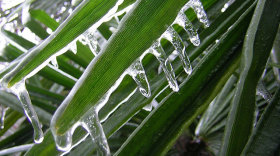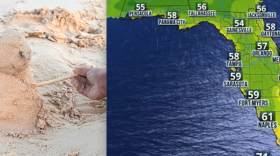IRA FLATOW, HOST:
This is SCIENCE FRIDAY. I'm Ira Flatow.
(SOUNDBITE OF APPLAUSE)
FLATOW: Yup, they were cheering again this week at the Jet Propulsion Laboratory. The Mars rover Curiosity made its first moves on the Red Planet. It wiggled its wheels, and it's rolling away from the landing site, toward a spot called Glenelg, actually you can spell it backwards and forwards the same way because it's going to return there.
But even before leaving tracks in the dust, Curiosity took Mars' temperature, and the weather report says it's a balmy 30 degrees Fahrenheit by day and dipping down into the negative 100s by night. It also zapped a rock with its onboard laser, vaporizing part of the rock to study its composition.
And now that it's headed away from Bradbury Base, what might it find? Remember the reports of methane on Mars? Can the rover sniff around to follow up on that mystery? Here to possibly answer all those questions, is Richard Cook. He's deputy project manager for the Mars Science Laboratory at JPL in Pasadena. He joins us by phone. Welcome to SCIENCE FRIDAY, Dr. Cook.
RICHARD COOK: Hi, Ira, how are you?
FLATOW: Hi there. So Curiosity took its first little wheels, it rocked, and it rolled today, or this week, rolling around.
COOK: It did. Yeah, it did. A couple days ago we drove backwards and forwards both, just to test out that the wheels, the motors would work and that the wheels were all in good shape. And so it was our first tracks on Mars, so to speak.
FLATOW: And what was the purpose of its first laser beam?
COOK: Well, that's a big part of the checkout of the - what we're doing for the first month or so is just going through and sort of systematically checking out each part of the rover, all of the science instruments, the basic mobility, capability, the arm, the different pieces just to make sure everything is okay after the voyage to Mars.
And then we'll start doing the science mission and really, in earnest, you know, start exploring the area around Bradbury's Landing. It's - in the case of ChemCam, we also get the benefit with the laser that we were actually able to do some early science measurements, as well. And so, as part of the checkout, we got science data in addition.
FLATOW: Do you have a rock in mind that you want to zap in earnest?
COOK: We did, yeah. Well, we actually zapped pretty much the area right around where the rover landed. And it's actually interesting to the scientists because the plume of the rocket engines actually, sort of, scoured out an area on both sides of the rover, which normally Mars is covered, all the surface area is covered, with a lot of dust.
And sort of as a beneficial byproduct of the rocket engines coming down close to the ground, it just sort of blew away all that dust and allowed us to actually take a measurement of the sort of uncovered material.
FLATOW: And what is your first destination?
COOK: Well, you mentioned the Glenelg area is where we're trying to go. We actually picked this particular landing site in Gale Crater because of Mount Sharp, which is the big mountain that you can see in some of the pictures, and that's the eventual destination that rover will head towards.
One of the benefits of all of the orbiting spacecraft around Mars, at this point, is that we're able to actually take lots of science measurements from orbit. And it turns out that there's an interesting rock outcropping a few hundred yards away from where the rover has set down. And so it's actually in the opposite direction from Mount Sharp, but because the scientists were sort of intrigued by that, they wanted to go check that out first.
And so, literally in the next few days, we'll begin to make our way over that way, and it'll take - it'll probably take two or three weeks to get there, depending on how much we stop.
FLATOW: So, tell us a bit more about what's so intriguing about this rock.
COOK: It's actually interesting because it's unlike - from orbit at least, it's unlike other rocks that we've seen on Mars, or it's an unusual sort of rock in that it has a lot of heat capacity. The heat capacity of the rock, if you think about it, things that are very lightweight like dust don't have very much heat capacity. They get hot, and they get cold very quickly.
Big rocks, you know, that are sort of out rock - outcroppings that are very heavy - it takes them a while to get hot and then a while to get cold at night, for example. In this particular case, what we see in this area is we can't see rock outcroppings, but we see what looks like a very flat area, where, you know, it would look like just soil.
But instead of being soil or dust-like in its heat capacity, it actually looks much higher. So what we think is happening is that it's a very sort of hard rock surface. And, you know, an analogous thing if you look from space here onto the Earth would be like a cement parking lot. Of course it's not a cement parking lot, but it would be something like that, where it wasn't dirt, but it was a very, very hard material.
And as I said, it's something that's pretty unusual for Mars, we haven't seen before, and so that's why they want to go check it out.
FLATOW: Are you going to zap it and drill it? Because I know you have a big drill onboard, too.
COOK: Yes, we will. We hope to. The idea of this drive is to give us time to check out the rest of the sampling hardware. We will be able to take ChemCam laser measurements as we go, but we do need to do a little bit more work to check out the scoop, for example, and the drill. And so that'll take us, you know, probably another month or so to get all that hardware checked out.
By that point, we hope to be at the - in the area of the Glenelg area, and so it'll be good timing to try to get our first samples.
FLATOW: So you'll be testing out while you're moving, along the way?
COOK: Yeah, we also - yes in the sense that there are some functions where we can stop partway and do pieces of it, check out various elements of it. We also want to do some testing here on the ground. There's some additional test work that we still need to finish up here on the ground, and so we'll do that while we're driving.
FLATOW: You know, I was surprised to see that it was pretty balmy during the day there, and then it gets really frigid at night. How do you protect all that electronics from freezing over when, you know, there's extremes of weather like that?
COOK: Well, the rover is designed to handle it. The electronics are - most electronics that you, you know, build for space can go down to - and operate down at the minus-50, minus-55 degree sort of level. We actually - most of our electronics that's inside the rover never gets that cold. The rover kind of keeps itself warm, you might say, and it doesn't get that cold inside the rover.
Excuse me. The things that we worry about are actually on the outside, and in particular there are some electronics out there which can get down to minus-100, and there's motors. And the motors have a problem, if you've ever tried to, you know, drive a car in very cold weather in the Midwest or the North during the winter, you know, the car, you can - it sometimes takes a little bit to get it moving because the lubrication sort of freezes up, and the motor has a hard time turning.
That's the problem we have when trying to operator motors on Mars when it's quite cold. And so we just - what we use is we use heaters. And we have little electrical heaters that a few hours before we want to drive or turn the science cameras, for example, we turn on heaters, we heat them up to the point where they're relatively warm, warm enough to operate, and then we're able to go ahead with the science observations.
FLATOW: You've obviously lived in Alaska or Minnesota if you know what a heater is on your car.
(LAUGHTER)
COOK: Exactly. Born in North Dakota, so yeah, I should know.
FLATOW: So of course you would have thought of that.
(LAUGHTER)
FLATOW: To put it in the car. And so after you go to the big rock, that'll be sort of the testing, your testing phase. Where would - would you turn around and then head back toward the mountain?
COOK: That's exactly right, yeah. We'll basically spend, you know, somewhere - I would say we'll spend two or three months, you know, between getting there, exploring the area around the Glenelg area, but really the scientists want to get to Mount Sharp. And so I think we'll, you know, very rapidly turn back around and head back, you know, in the direction of the big target that the scientists have picked.
And we just need to make - you know, at that point I think they'll be - that curiosity will be sort of satisfied temporarily at least, and they'll just want to get to the main target of the mission.
FLATOW: You know, there are a lot of people that are wondering that - are there traces of methane. We've seen possible traces of methane, which they speculate might come from organisms, or past or present. Can you sniff the Martian air and see if there's any methane there?
COOK: Yes, we can. In fact, we're doing it today for the first time. The mission has onboard, in addition, sort of a chemistry laboratory. And one of the purposes of the chemistry laboratory, of course, is to look at the rocks and soil that we're able to process and in particular look for organic material that hopefully would be there from ancient times on Mars, when it was more habitable.
But in addition to that, that same instrument can actually also just suck in Mars atmosphere and can look for methane. And methane is definitely something that we think is primarily associated with biological sources, obviously here on the Earth.
There are some ways in which methane can be created without, you know, living organisms, and so we need to be able to differentiate between the two. But yeah, Mars, there have been investigations done from here on the Earth where we're looking through telescopes at Mars, and we see indications of methane.
And I think hopefully, like I said in the first, next few days, we'll begin to at least see whether or not we can detect similar things.
FLATOW: You know, when you touched down, there were people who were talking about gee, this looks just like the Southwest, down in the desert there. Can you smell it, as if it might be the Southwest? Is there any way to say gee, it smells like the Southwest?
(LAUGHTER)
COOK: Well, I think that the Southwest has got a lot of smells that come from living things, despite the fact that it's very dry. And so I don't think it'll smell quite like that. But in a way, that's what we're doing with the SAM instrument is we're smelling Mars to see what it's like.
FLATOW: Do you have any backup, like a couple of people have tweeted, do you have backup drill bits in case - everybody breaks a drill bit, you know?
COOK: Yeah, we do. That's actually one of the more - you know, as amazing as the landing system was with the Sky Crane and everything, the rover is a great work of engineering itself, and in particular the drill is the first time we've taken a - it's essentially a hammer drill for the home enthusiast there. You know, you can use it to drill into concrete with.
It both rotates, and it vibrates. And you're exactly right. One of the things anybody who has a hammer drill at home notices is that they break bits. And so we actually have carried a set of spare bits, just two that are on the front of the rover, and actually without essentially any - I mean, we have to tell it to do it, but the spacecraft of the rover has the ability on its own to release the bit that's currently on the drill and to put a new one on, all while it's on Mars.
FLATOW: No need to go to Sears on Mars, then.
COOK: That's right, that's right.
FLATOW: Thank you very much, Dr. Cook, for taking time to be with us today. And we'll be in touch.
COOK: Thank you.
FLATOW: You're welcome. Richard Cook, deputy project manager for the Mars Science Laboratory at JPL. We're going to take a break, and we're going to talk about the fires that have ravaged the Western U.S., leaving millions of acres charred. Are we on track for a record year? Can you predict the paths of these fires? And what can you learn from tree rings to tell you about fires of the past? We're going to talk about all of that. So stay with us, we'll be right back after this break.
(SOUNDBITE OF MUSIC)
FLATOW: I'm Ira Flatow; this is SCIENCE FRIDAY from NPR. Transcript provided by NPR, Copyright NPR.







